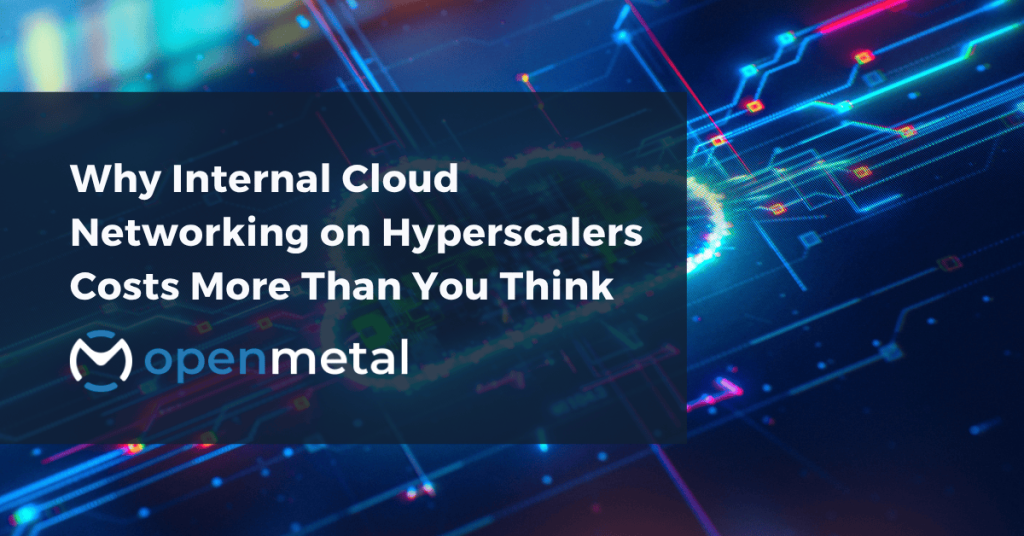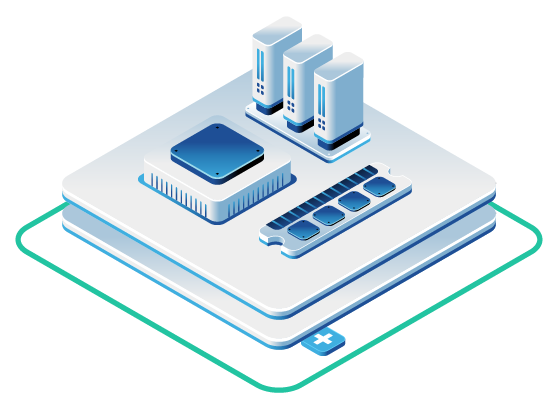
Ready to build on cloud infrastructure that treats internal networking as the strategic asset it is?
The OpenMetal team is standing by to assist you with scoping out a fixed-cost model based infrastructure plan to fit your team’s requirements, budgets, and timelines.
Key Takeaways
- East-west traffic now dominates modern data centers, accounting for the majority of internal communications between microservices, APIs, and distributed systems
- Hyperscale cloud providers often hide east-west traffic costs and performance characteristics behind opaque pricing models and shared network fabrics
- OpenMetal’s dedicated hardware approach provides transparent, predictable east-west networking with 20 Gbps NICs (dual 10Gbps) and zero internal traffic charges
- Applications like AI training, real-time analytics, and microservice platforms benefit dramatically from optimized east-west network performance
- Treating east-west traffic as a controllable design variable rather than a hidden cost enables better architecture decisions and cost management
When you architect cloud applications today, you’re likely thinking about how users connect to your services—the familiar north-south traffic pattern. But here’s what most organizations miss: the real network bottleneck isn’t at your perimeter anymore. It’s happening inside your infrastructure, between your own services.
Welcome to the age of east-west traffic dominance, where internal communications have eclipsed external connections in both volume and importance. If you’re running microservices, training AI models, or processing real-time data pipelines, understanding and controlling this lateral flow of data isn’t optional—it’s the difference between a performant architecture and an expensive, unpredictable one.
Defining East-West vs. North-South Traffic
Before we dive deeper, let’s establish what we’re talking about. Network traffic within a data center moves between devices in that specific facility, creating what’s known as east-west traffic patterns. Think of your network diagram: services spread horizontally communicate laterally, hence “east-west.”
In contrast, north-south traffic describes the flow between clients and servers, moving data into or out of your data center environment. This is the traditional traffic pattern that dominated infrastructure design for decades—users making requests to your applications, your applications responding back.
The terminology comes from how we typically draw network diagrams: servers and access switches spread out horizontally on the page, with external connections at the top or bottom. When data moves between those horizontal elements, it’s traveling east-west. When it enters or exits through those vertical connections, it’s north-south.
Here’s the shift that changes everything: the volume of lateral traffic within data centers has now surpassed conventional north-south traffic. Your internal communications now generate more network activity than all your user interactions combined.
Why Modern Cloud-Native Apps Are “East-West Heavy”
The explosion in east-west traffic isn’t random—it’s a direct consequence of how we build applications today. Three architectural shifts have fundamentally changed internal traffic patterns.
Microservices and Service Decomposition
Microservices architecture structures applications as sets of independently deployable services organized around business capabilities, with each service capable of being developed and scaled separately. But here’s the catch: all those independent services still need to talk to each other constantly.
A single user request might trigger dozens of internal service calls. Your authentication service talks to your user database. Your product catalog service queries inventory. Your recommendation engine pulls from multiple data sources. Your payment processor validates with fraud detection. Each of these interactions generates east-west traffic.
API-Driven Architectures
Modern applications expose functionality through APIs, creating constant internal chatter. Modern workflows, especially microservices and containerized deployments, can generate terabytes of internal traffic daily. Your front-end makes API calls to your back-end. Your back-end services make API calls to each other. Your monitoring systems poll metrics from every component.
This isn’t occasional communication—it’s continuous, high-frequency exchanges that keep your distributed system synchronized and functional.
Service Meshes and Advanced Orchestration
Service mesh platforms like Istio simplify traffic routing and service-level configuration, enabling features like A/B testing, canary deployments, and staged rollouts. But implementing these capabilities requires proxies that intercept and process every internal request.
Each request flowing through a mesh traverses both client-side and server-side proxies, adding layers of communication to the network fabric. The benefits are substantial—better observability, security, and traffic control—but the east-west traffic volume increases accordingly.
Data-Intensive Workloads
The proliferation of data-intensive applications, big data analytics, machine learning, and real-time streaming has dramatically impacted traffic patterns within data centers. When you’re training neural networks, multiple nodes need to synchronize gradients constantly. When you’re running real-time analytics, data flows between storage, processing, and aggregation layers continuously.
These workloads don’t just increase east-west traffic incrementally—they multiply it by orders of magnitude.
The Hyperscaler Problem: Hidden Costs and Opaque Performance
Public cloud providers promise unlimited scale and flexibility, but they handle east-west traffic in ways that create serious challenges for architecture teams.
Hidden Egress Costs for Internal Chatter
Here’s what catches most teams off guard: hyperscalers frequently charge for data transfer between availability zones, regions, or specific service endpoints. What you think of as “internal” traffic might actually be generating substantial bills.
On AWS, data transfer between availability zones in the same region costs $0.01 per GB in each direction, while inter-region transfers start at $0.02 per GB and can reach higher rates depending on the regions involved. Your Kubernetes pods in different availability zones generate these charges. Your database replication across zones for high availability adds more costs. Your service mesh routing requests through multiple hops compounds the expense.
The pricing models are complex and often opaque. You won’t know the true cost until the bill arrives, making capacity planning and budget forecasting nearly impossible.
No Transparency on Packet Flows
In shared public cloud environments, you have minimal visibility into how your packets actually traverse the network. Where do your requests go? What path do they take? What resources are shared with other tenants? How does that sharing affect your performance?
You’re essentially flying blind. Your monitoring shows request latency, but you can’t see whether that latency comes from your application logic or from network congestion in infrastructure you don’t control.
Unpredictable Performance in Shared Fabrics
As virtual functions and software-defined networking components relay data to each other within shared infrastructure, they can increase latency and cause network congestion. Your performance is at the mercy of noisy neighbors and infrastructure decisions made by the cloud provider.
One day your internal service calls complete in milliseconds. The next day, during peak hours or when a neighbor’s workload spikes, those same calls take ten times longer. You can’t predict it, and you can’t fix it—because you don’t control the underlying network.
The OpenMetal Difference: Dedicated Hardware for Controlled East-West Flows
OpenMetal takes a fundamentally different approach to east-west traffic—one that gives you visibility, control, and predictability.
Dedicated Hardware Clusters = Isolated East-West Networks
Each customer’s private cloud runs on dedicated hardware with isolated network fabrics. This means your east-west traffic flows through infrastructure that serves only your workloads. There’s no sharing, no noisy neighbors, and no competition for bandwidth.
When your microservices communicate, they’re using network resources dedicated to your applications. The performance you measure today is the performance you’ll see tomorrow and next month.
20 Gbps NICs + Free Internal Traffic
OpenMetal includes 20 Gbps (dual 10Gbps) network interface cards in every deployment, providing substantial bandwidth for internal communications. But here’s the game-changer: there are no charges for internal networking between your nodes.
Your Kubernetes pods can communicate as much as they need. Your storage nodes can replicate data continuously. Your distributed databases can maintain consistency across replicas. None of this generates additional costs.
This fundamentally changes how you architect applications. Instead of optimizing to minimize internal traffic to control costs, you can optimize for performance and resilience. Want to add redundant health checks? Go ahead. Want to increase replication factor? No problem. Want to implement a chatty service mesh for better observability? The networking cost is already included.
VXLAN Segmentation for Controlled Traffic Flows
While having powerful networking is valuable, you also need to control and segment that traffic for security and performance optimization. OpenMetal supports VXLAN overlays, allowing you to create virtual networks that segment traffic while keeping the underlying fabric transparent and observable.
You can isolate different application tiers, create separate networks for different security zones, or segment by environment (development, staging, production)—all while maintaining visibility into actual traffic flows and performance characteristics.
Use Cases That Depend on East-West Performance
Certain application patterns are particularly sensitive to east-west network performance. These workloads either succeed or fail based on internal communication efficiency.
AI/ML Training Synchronization
When you’re training large models across multiple GPUs or nodes, the bottleneck isn’t usually compute—it’s gradient synchronization. After each training batch, nodes need to share and synchronize their updates. This creates massive east-west traffic bursts.
Data-intensive workloads generate extensive data flows between servers for processing, analysis, and storage. In hyperscaler environments, this synchronization traffic can become prohibitively expensive or unpredictably slow. With OpenMetal’s dedicated networking, you get consistent, high-speed communication without surprise costs.
Real-Time Analytics Pipelines
Real-time analytics systems move data continuously between ingestion, processing, storage, and query layers. Stream processing frameworks like Apache Kafka, Flink, or Spark generate constant internal traffic as they shuffle data between nodes.
The performance of these pipelines depends entirely on east-west network throughput and latency. A 10ms increase in inter-node latency can cascade into seconds of additional end-to-end processing time. When your networking is predictable and dedicated, your analytics performance becomes predictable too.
SaaS Platforms with Chatty APIs
Modern SaaS platforms often implement API-first architectures where front-end services make dozens of back-end calls for every user action. The cumulative effect of these “chatty” APIs creates substantial east-west traffic.
In environments where internal traffic is metered or shares bandwidth unpredictably, this architecture becomes expensive and risky. With OpenMetal, you can build richly interconnected services without worrying that your architectural choices will blow up your network costs or degrade under load.
Distributed Databases and Storage Systems
Databases like Cassandra, MongoDB, or PostgreSQL with replication require constant communication between nodes for consistency, replication, and cluster coordination. Healthcare organizations running electronic medical record systems, for example, require continuous server-to-server communication across campus facilities for rapid sharing of test results and medication management.
The performance and reliability of these systems depend on fast, stable east-west networking. When every write must be replicated across multiple nodes, network latency directly impacts your application’s write performance.
Treating East-West as a Design Variable, Not Hidden Overhead
Here’s the fundamental difference in mindset: hyperscalers treat east-west traffic as an implementation detail—something they’ll handle for you, but also something they’ll charge for and control. OpenMetal treats it as a design variable you should have full authority over.
Tuning for Your Workload
With transparent access to network performance characteristics and no metered internal traffic, you can make architecture decisions based purely on what’s best for your application. Should you cache aggressively or query frequently? Should you normalize data or denormalize for performance? Should you batch requests or stream them?
These decisions often involve trade-offs between network traffic and other resources. When networking is opaque and expensive, you’re forced to optimize blindly or conservatively. When it’s transparent and included, you can tune based on actual measured performance.
Performance as Strategy, Not Guesswork
In shared environments, network performance is largely out of your control. You can architect well and still suffer from factors beyond your influence. This turns performance optimization into educated guessing.
With dedicated infrastructure, performance becomes strategic. You can measure accurately, optimize precisely, and predict reliably. If your application needs sub-millisecond internal latency, you can architect for it and actually achieve it.
Cost Predictability Enables Better Planning
When east-west traffic generates unpredictable costs, capacity planning becomes a risk management exercise. You might over-provision to avoid surprises, wasting money on unused capacity. Or you might under-provision and face budget overruns when traffic scales.
With OpenMetal’s model, internal networking costs are fixed regardless of utilization. This lets you plan infrastructure costs based on actual resource needs rather than pessimistic traffic projections. Your CFO will thank you for the predictability.
Conclusion: East-West as Competitive Advantage
The explosion of east-west traffic isn’t slowing down—it’s accelerating. As applications become more distributed, data-intensive, and intelligent, internal communications will continue to dominate your network profile.
In this environment, how you handle east-west traffic determines whether your infrastructure enables or constrains your applications. Hyperscalers abstract away the problem, but in doing so, they also abstract away your control and predictability. You’re left optimizing in the dark, managing costs reactively, and hoping performance remains acceptable.
OpenMetal’s approach gives you something different: transparency, control, and predictability. You get dedicated hardware that ensures consistent performance. You get powerful networking with no metered internal traffic. You get the visibility and control to tune your architecture for your specific needs.
East-west traffic isn’t overhead to minimize—it’s the nervous system of your distributed application. When it works well, everything works well. When it’s constrained or unpredictable, everything suffers.
The question isn’t whether east-west traffic matters. It’s whether you want to control it or just hope it works out.
Explore OpenMetal’s private cloud solutions and discover how dedicated hardware and transparent networking can transform your application architecture.
FAQ
Q: How much does east-west traffic typically cost on major public cloud providers?
Costs vary by provider and architecture, but inter-zone traffic often ranges from $0.01 to $0.02 per GB, and inter-region traffic can exceed $0.09 per GB. For applications generating terabytes of internal traffic daily, this adds up to thousands of dollars monthly. OpenMetal includes all internal traffic at no additional charge, regardless of volume.
Q: Can I monitor and analyze east-west traffic patterns in OpenMetal’s environment?
Absolutely. Because you have dedicated hardware and transparent network fabric, you can implement comprehensive monitoring using tools like Prometheus, Grafana, or your preferred network observability platform. You’ll see actual packet flows, latency characteristics, and bandwidth utilization—visibility that’s difficult or impossible to achieve in shared public cloud environments.
Q: What types of applications benefit most from optimized east-west networking?
Applications with distributed architectures see the biggest gains: microservices platforms with many inter-service calls, AI/ML training systems that synchronize across nodes, real-time data processing pipelines, distributed databases with replication, and service meshes with sidecar proxies. Any workload where internal communication frequency or performance is critical benefits from OpenMetal’s approach.
Q: How does OpenMetal’s networking compare to hyperscaler performance?
OpenMetal provides 20 Gbps NICs (dual 10Gbps) on dedicated hardware, meaning you’re not competing with other tenants for bandwidth. Performance is consistent and predictable because the network fabric serves only your workloads. In contrast, shared public cloud environments may provide high theoretical bandwidth but actual performance varies based on multi-tenancy and network congestion you can’t observe or control.
Read More Blog Posts
Works Cited
- “East-west traffic.” Wikipedia, Wikimedia Foundation, 9 Aug. 2025, https://en.wikipedia.org/wiki/East-west_traffic.
- “What is east-west traffic?” HAProxy, 25 June 2025, https://www.haproxy.com/glossary/what-is-east-west-traffic.
- “Managing East West Traffic: Examples, Challenges, and Best Practices.” Faddom, 24 Aug. 2025, https://faddom.com/managing-east-west-traffic-examples-challenges-and-best-practices/.
- “Embracing the Shift: The Rise of East to West Traffic and its Impact on Data Center Architecture.” CableXpress, 2 June 2023, https://www.cablexpress.com/blog/embracing-the-shift-the-rise-of-east-to-west-traffic-and-its-impact-on-data-center-architecture.
- “The Istio service mesh.” Istio, https://istio.io/latest/about/service-mesh/.


































